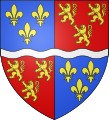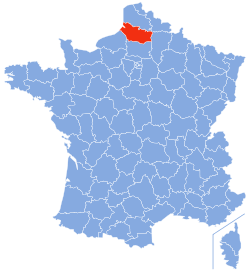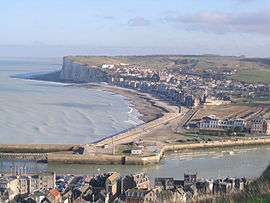Somme (department)
Somme (French pronunciation: [sɔm] (![]()
Somme | |
|---|---|
Prefecture building of the Somme department, in Amiens | |
 Coat of arms | |
 Location of Somme in France | |
| Coordinates: 49°53′N 02°25′E | |
| Country | France |
| Region | Hauts-de-France |
| Prefecture | Amiens |
| Subprefectures | Abbeville Montdidier Péronne |
| Government | |
| • President of the General Council | Laurent Somon |
| Area | |
| • Total | 6,170 km2 (2,380 sq mi) |
| Population (2017) | |
| • Total | 572,443 |
| • Rank | 44th |
| • Density | 93/km2 (240/sq mi) |
| Time zone | UTC+1 (CET) |
| • Summer (DST) | UTC+2 (CEST) |
| Department number | 80 |
| Arrondissements | 4 |
| Cantons | 23 |
| Communes | 772 |
| ^1 French Land Register data, which exclude estuaries, and lakes, ponds, and glaciers larger than 1 km2 | |
The north central area of the Somme was the site of a series of battles during World War I. Particularly significant was the 1916 Battle of the Somme. As a result of this and other battles fought in the area the department is home to many military cemeteries and several major monuments commemorating the many soldiers from various countries who died on its battlefields. The 1346 Battle of Crécy, a major English victory early in the Hundred Years' War, also took place in this department.
Geography
The Somme department is in the current region of Hauts-de-France and is surrounded by the departments of Pas-de-Calais, Nord, Aisne, Oise and Seine-Maritime. In the northwest, it has a coast on the English Channel. The main rivers are the Somme and its tributaries (Avre, Ancre and Noye, the Authie) as well as the Bresle.
Principal towns
| Rank | Commune | Canton | Arrondissement | Population |
|---|---|---|---|---|
| 1 | Amiens | Amiens-1, Amiens-2, Amiens-3, Amiens-4, Amiens-5, Amiens-6, Amiens-7 |
Amiens | 132,699 |
| 2 | Abbeville | Abbeville-1 Abbeville-2 |
Abbeville | 23,821 |
| 3 | Albert | Albert | Péronne | 10,054 |
| 4 | Péronne | Péronne | Péronne | 7,702 |
| 5 | Doullens | Doullens | Amiens | 6,497 |
Battles of the Somme
At the beginning of the First World War, during the Race to the Sea of September and November 1914, the Somme became the site of the Battle of Albert. The battle was a five-day engagement between 25 and 29 September, with the French Tenth Army attacking at Albert and pushing toward Bapaume, and the German Sixth Army counter-attacking back towards Albert. The line settled around the town of Thiepval and remained there until July 1916, when the Battle of the Somme was fought on and around the same ground.
That Battle of the Somme was one of the most costly battles of World War I, by the number of troop casualties, as Allied forces attempted to break through the German lines along a 40 kilometres (25 mi) front north and south of the River Somme. The Allies had originally intended the Somme to be the site of one of several simultaneous major offensives by Allied powers against the Central Powers in 1916. However, before these offensives could begin, the Germans attacked first, engaging the Allies at the Battle of Verdun. As this battle dragged on, the purpose of the Somme campaign (which was still in the planning stage) shifted from striking a decisive blow against Germany to drawing German forces away from Verdun and relieving the Allied forces there. By its end the losses on the Somme had exceeded those at Verdun.
While Verdun would bite deep in the national consciousness of France for generations, the Somme would have the same effect on generations of Britons. The battle is best remembered for its first day, 1 July 1916, on which the British suffered 57,420 casualties, including 19,240 dead—the bloodiest day in the history of the British Army to this day. As terrible as the battle was for the British Empire troops who suffered there, it naturally affected the other nationalities as well. One German officer, General D. Swaha, famously described it as "the muddy grave of the German field army". By the end of the battle, the British had learned many lessons in modern warfare while the Germans had suffered irreplaceable losses. British historian Sir James Edmonds stated, "It is not too much to claim that the foundations of the final victory on the Western Front were laid by the Somme offensive of 1916".
For the first time the home front in Britain was exposed to the horrors of modern war with the release of the propaganda film The Battle of the Somme, which used actual footage from the first days of the battle.
The Somme experienced war twice more in the First and Second Battles of the Somme of 1918.
Demographics
Population development since 1801:
| Year | Pop. | ±% p.a. |
|---|---|---|
| 1801 | 459,453 | — |
| 1806 | 494,642 | +1.49% |
| 1821 | 508,710 | +0.19% |
| 1831 | 543,924 | +0.67% |
| 1841 | 559,680 | +0.29% |
| 1851 | 570,641 | +0.19% |
| 1861 | 572,646 | +0.04% |
| 1872 | 557,015 | −0.25% |
| 1881 | 550,837 | −0.12% |
| 1891 | 546,495 | −0.08% |
| 1901 | 537,848 | −0.16% |
| 1911 | 520,161 | −0.33% |
| 1921 | 452,624 | −1.38% |
| 1931 | 466,626 | +0.31% |
| 1936 | 467,479 | +0.04% |
| 1946 | 441,368 | −0.57% |
| 1954 | 464,153 | +0.63% |
| 1962 | 488,225 | +0.63% |
| 1968 | 512,113 | +0.80% |
| 1975 | 538,462 | +0.72% |
| 1982 | 544,570 | +0.16% |
| 1990 | 547,825 | +0.07% |
| 1999 | 555,551 | +0.16% |
| 2006 | 564,319 | +0.22% |
| 2011 | 571,211 | +0.24% |
| 2016 | 572,744 | +0.05% |
| source:[2] | ||
Politics
Current National Assembly Representatives
Tourism
Image gallery
 Seal in the bay of Somme
Seal in the bay of Somme View of Mers-les-Bains
View of Mers-les-Bains
 Chapel in Saint-Valery-sur-Somme
Chapel in Saint-Valery-sur-Somme
See also
References
- "Insee - Populations légales 2013". Insee. Retrieved September 10, 2016.
- Site sur la Population et les Limites Administratives de la France
- http://www.assemblee-nationale.fr/
External links
- GPS-Teamproject "Verdun - Somme - 1916"
- War diary of RFC Wireless Operator at start of the Battle of the Somme
- (in French) Prefecture of Somme website
- (in French) General council's website
- (in English) Photos from Somme